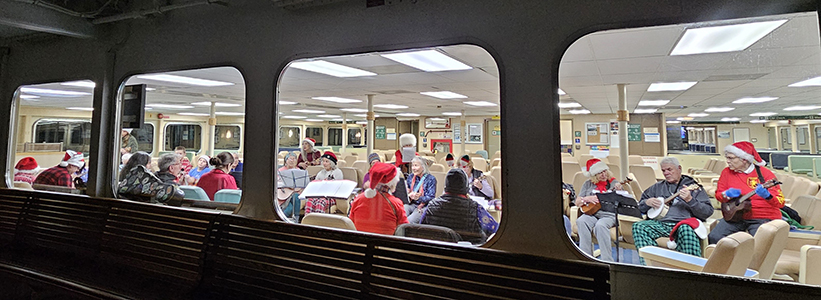–by Rep. Rick Larsen —
I am working on a long-term plan to respond to people’s concerns about jet noise out of Naval Air Station Whidbey Island. While my support for NASWI remains steadfast, I am also committed to partnering with local officials, community members and the Navy to address the impacts of noise across the north Puget Sound region.
The concerns I hear vary from Coupeville to Lopez Island, and the solutions I am pursuing will not satisfy everyone in all of these communities. But it is important to me to take steps to address my constituents’ concerns and the needs of the Navy to find collaborative solutions. I began working on a seven point plan in late 2014. I want to share the progress I have made on each of these ideas to help mitigate the impact of jet noise on our communities while ensuring our Navy pilots get the training they need to perform their vital missions.
Making sure people understand the number of Growlers at NASWI
After talking with many people on Whidbey Island toward the end of 2014, I recognized there was some confusion about the number of Growlers currently at NASWI, as well as the number the base may fly in the future. Through an op-ed in the Whidbey News-Times and communicating directly with constituents at meetings and through letters, I dispelled incorrect rumors about the number of Growlers doubling at the base and clarified accurate information. We know there are 82 Growlers flying out of NASWI. An additional 17 planes are used as backup in case an active plane is damaged. The number of Growlers to be based at NASWI in the future will be determined by the ongoing Environmental Impact Statement (EIS) that the Navy is working on. A draft EIS is expected this fall and will be open for people to provide comments. The EIS will also set the standard for the number of operations at Ault Field and Outlying Field (OLF) Coupeville. In the past, I have pushed to ensure the Navy reaches out widely to communities impacted by the base, and I will continue to do so.
Pushing to reduce noise from engine testing
Engine tests on the ground at Ault Field can be heard from places on North Whidbey Island and across the water in the southern portions of the San Juan Islands. While some Navy facilities have specially designed hangars to muffle noise from these activities, NASWI does not. Senator Patty Murray and I asked the Navy to fund the construction of a ‘hush house’ at Ault Field. We also pushed successfully for the Navy to include the impacts of a hush house in the EIS.
Advancing technology to reduce engine noise
Ongoing research may produce attachments to Growler engines, called chevrons, that could muffle jet noise without sacrificing engine performance. I included language in the 2016 defense policy bill indicating Congressional support for the research and putting in place oversight to keep the Navy working on this technology. The first flight testing took place in 2015, and the Navy found that the current chevron design is successful at quieting engines at most settings, but was less effective at higher levels of power. The Navy is using this information to work up new, more effective chevron designs. I will continue to track progress of this research.
Supporting technology to reduce future training flights, maintain training standards
Landing on a carrier is one of the most dangerous tasks in aviation. The Navy rightly requires a significant number of Field Carrier Landing Practices (FCLPs) before a pilot can be certified or recertified to deploy on board a carrier. Navy engineers are currently developing a software package for the Growler that could improve pilot safety and reduce the amount of training pilots need by increasing automation. Making carrier landings more automated could safely reduce the number of training flights pilots need. I included language in a draft of the 2017 defense policy bill last week to advance the Navy’s work on this software package and maintain the momentum behind using technology to improve pilot training and safety.
Expanding the Navy’s noise measurements to all impacted communities
The Navy conducted noise measurements on Whidbey Island as part of the EIS process. I asked the Navy to increase its outreach to other communities that are impacted by noise from the base. At my urging, the Navy held a public meeting on Lopez Island to listen to citizens’ concerns about jet noise and answer questions about potential changes to base operations. Base officials also performed informal sound tests last year in areas on Lopez Island and discovered a significant noise difference between jets flying with landing gear up versus down. The base is now directing pilots to keep their wheels up when conditions allow until they are over water when they are flying approaches that go over Lopez Island to lessen the noise level.
Publicizing flight training schedules for Ault Field
NASWI currently publishes a weekly schedule of Growler Field FCLPs at OLF Coupeville. Community members have suggested to me that the base also publish a schedule for FCLPs at Ault Field to try to give people impacted by jet noise from Ault Field this same advanced notice. I have shared this recommendation with base leadership and will continue asking them to pursue this proposal.
Using community data to understand noise impacts in the San Juans
Residents on the San Juan Islands experience jet noise, and officials from San Juan County have proactively addressed citizens’ concerns by setting up a database for people to report noise. I am working to facilitate communication between the community and the Navy to ensure data are collected in a way that is maximally useful.
As the representative of the Second Congressional District, I take seriously my responsibility to address concerns, questions and ideas that I hear from my constituents. That is why I have been working on several different approaches to address the varying concerns people have about the impacts of Growlers flying out of NASWI. Some of the strategies I am pursuing will take more time, like integrating new technology into the Navy’s operations. I am also open to other ideas that people have to lessen the impacts of jet noise.
NASWI is one of the Navy’s premier assets. I remain committed to ensuring the base stays strong and our pilots get the training they need. I continue to support the Growler aircraft, their crews, and the FCLPs at OLF Coupeville. We can take steps to uphold the base’s critical role in our national defense while lessening the disruptions that Growlers cause for residents. I will keep working on collaborative solutions.
**If you are reading theOrcasonian for free, thank your fellow islanders. If you would like to support theOrcasonian CLICK HERE to set your modestly-priced, voluntary subscription. Otherwise, no worries; we’re happy to share with you.**








First of all I do sympathize with those affected by the noise from military planes from NASWI. On Orcas we rarely hear any jets flying over and only an occasional private jet landing at the Eastsound Airport. However, I live just two blocks from the airport and even during the annual Fly-In am not disturbed by the additional noise associated with a lot more take offs and landings. Med-Evac, including Coast Guard helicopters make many trips in and out of our airport, the choppers definitely nosier than the other planes, but when they fly over I know someone is hurt of ill and needs help getting to the hospital. As far as the Naval Air Station on Whidbey, I would much rather have to listen to the loud noise knowing those are the men and women who are protecting us and put it off to more of an inconvenience than a nuisance. That air station has been there long before many of us ever even thought of moving to the San Juan Islands, and I hope it remains. It would be wonderful if the noise from the planes could be quieter or buffered in some way. Thank you Rick for doing what you can to address this issue, and a sincere thank you to the Navy personnel serving our country to protect us. One of my grandsons is in the Navy stationed in San Diego, and I am proud of him as well as all who serve.
Many people are not bothered by noise as evidenced by all the houses built on both sides of the road leading to the ferry. The Whidbey Naval Air Station was opened in 1942. We were involved in two very large wars. Oak Harbors population in 1940 was 370. No one really to disturb. The base should be relocated as the land is way more valuable for high end homes that would generate lots of sales tax during construction and lots and lots of property tax as the homes built would be very high end. Representative Larson danced around the noise issue. Giving people information does not reduce noise pollution. We moved from Lopez to Orcas because we could hear them tuning the engines on School Rd which is in the middle of the island. He is in a tough spot in that he wants to get reelected and there are a lot of voters on Whidbey Island. The business leaders in Oak Harbor think their economy would crash if the base moved. If the base moved there would be an unbelievably large building boom probably replacing what would be lost. The Second World War is over. Just because we have always done something a certain way does not mean we must always continue on that path. Rep Larson must do his homework. What would be the economic loss if Whidbey left and what would the projected tax and business revenue be with the building boom. This process should not be adversarial. The case for the base moving should be made by showing Oak Harbor that they would be MORE prosperous with a building boom.
Good logic Harvey. Thanks Spirit Eagle